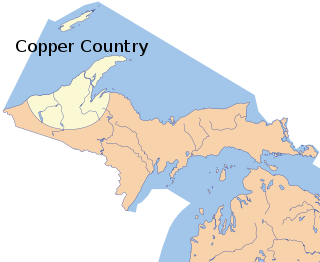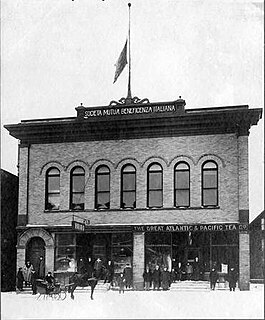
McCormick Place is the largest convention center in North America. It consists of four interconnected buildings and one indoor arena sited on and near the shore of Lake Michigan, about 2 mi (3.2 km) south of downtown Chicago, Illinois, United States. McCormick Place hosts numerous trade shows and meetings. The largest regular events are the Chicago Auto Show each February, the International Home and Housewares Show each March and the National Restaurant Association Annual Show each May.

Calumet is a village in Calumet Township, Houghton County, in the U.S. state of Michigan's Upper Peninsula, that was once at the center of the mining industry of the Upper Peninsula. Also known as Red Jacket, the village includes the Calumet Downtown Historic District, listed on the National Register of Historic Places (NRHP). The village may itself be included within the Calumet Historic District, a larger area which is NRHP-listed and which is a National Historic Landmark District. It is bordered on the north by Calumet Township, on the south by the unincorporated towns of New Town and Blue Jacket, on the east by Blue Jacket and Calumet Township, and on the west by Yellow Jacket and Calumet Township. The population was 726 at the 2010 census. Calumet's nickname is Copper Town U.S.A.

The Keweenaw Peninsula is the northernmost part of Michigan's Upper Peninsula. It projects into Lake Superior and was the site of the first copper boom in the United States. As of the 2000 census, its population was roughly 43,200. Its major industries are now logging and tourism, as well as jobs related to Michigan Technological University and Finlandia University.

The Copper Country is an area in the Upper Peninsula of Michigan in the United States, including all of Keweenaw County, Michigan and most of Houghton, Baraga and Ontonagon counties as well as part of Marquette County. The area is so named as copper mining was prevalent there from 1845 until the late 1960s, with one mine continuing through 1995. In its heyday, the area was the world's greatest producer of copper.

The Calumet River is a system of heavily industrialized rivers and canals in the region between the neighborhood of South Chicago in Chicago, Illinois, and the city of Gary, Indiana. Historically, the Little Calumet River and the Grand Calumet River were one, the former flowing west from Indiana into Illinois, then turning back east to its mouth at Lake Michigan at Marquette Park in Gary.

Dee Stadium, also called The Dee, is an ice hockey arena in Houghton, Michigan, that replaced, and is located on the same site as, the Amphidrome. It is regarded as the birthplace of professional hockey, and is the seventh oldest indoor ice rink in the world.

The Italian Hall Disaster was a tragedy that occurred on December 24, 1913, in Calumet, Michigan. Seventy-three men, women, and children, mostly striking mine workers and their families, were crushed to death in a stampede when someone falsely shouted "fire" at a crowded Christmas party.

Keweenaw National Historical Park is a unit of the U.S. National Park Service. Established in 1992, the park celebrates the life and history of the Keweenaw Peninsula in the Upper Peninsula of the U.S. state of Michigan. As of 2009, it is a partly privatized park made up of two primary units, the Calumet Unit and the Quincy Unit, and 21 cooperating "Heritage Sites" located on federal, state, and privately owned land in and around the Keweenaw Peninsula. The National Park Service owns approximately 1,700 acres (690 ha) in the Calumet and Quincy Units. Units are located in Baraga, Houghton, Keweenaw, and Ontonagon counties.

Mont Ripley is a ski hill located in Franklin Township, Houghton County, in Michigan's Upper Peninsula. The site is just outside the cities of Hancock and Houghton. It is owned by Michigan Technological University. It was founded in the early 1900s by Fred Pabst Jr.. With the addition of snow making in 2000, the season has been extended from late November to late March or early April.

While it originated thousands of years earlier, copper mining in Michigan became an important industry in the 19th and early 20th centuries. Its rise marked the start of copper mining as a major industry in the United States.

Calumet Air Force Station is a closed United States Air Force General Surveillance Radar station. It is located 5.2 miles (8.4 km) east-southeast of Phoenix, Michigan. It was closed in 1988 by the Air Force, and turned over to the Federal Aviation Administration (FAA).

Kearsarge is an unincorporated community in Calumet Township, Houghton County in the U.S. state of Michigan. It is approximately 2 miles (3.2 km) northeast of Calumet/Laurium on U.S. Route 41/M-26 at 47°16′30″N88°24′58″W.
The Detroit and Lake Superior Smelter was a copper smelter located near Hancock, Michigan on the Keweenaw Waterway. It was opened in 1860 by the Portage Lake Copper Company. The company later merged with the Waterbury and Detroit Copper Company to form the Detroit and Lake Superior Company. The Calumet and Hecla Mining Company used the smelter until it built its own near Hubbell, Michigan and Black Rock, New York in 1887 and 1891 respectively.
Arcadian mine was a copper mine developed in 1898 near Paavola, in Franklin Township, a short distance northeast of Hancock, in Houghton County, Michigan. The initial public offering was managed by Boston financier Thomas W. Lawson. The mine was owned and managed by Arcadian Copper Company in which some Standard Oil directors had a significant interest.
The Osceola Mine was a copper mine consisting of 11 shafts located in Osceola Township, Houghton County, Michigan. In 1895, it was the site of the deadliest mine disaster in the Copper Country.

Temple Jacob is a small historic synagogue in Michigan's Upper Peninsula. It owes its origins to the copper boom in the Keweenaw Peninsula in the late 19th and early 20th century. The first Jewish synagogue in the Copper Country, it is also the oldest, continuously active Jewish House of Worship in the Upper Peninsula and the only active synagogue in Michigan listed on the National Historic Register as part of the East Hancock Neighborhood Historic District. The synagogue, which is located near the north end of the lift bridge which connects the two towns of Houghton and Hancock, celebrates its Centennial anniversary in August, 2012. It was built on land purchased from the Quincy Mining Company and was dedicated in September 1912. The cornerstone inscribes the building in memory of Jacob, son of Israel Gartner, who was a generous contributor and fundraiser. He died shortly before the building was completed.

Anna "Big Annie" Klobuchar Clemenc was an American labor activist. Born in Calumet, Michigan, she founded and served as president of the local Women's Auxiliary No. 15 of the Western Federation of Miners and was an active participant in the Copper Country Strike of 1913–1914. She is an inducted member of the Michigan Women's Hall of Fame.

The Calumet Colosseum is an ice hockey arena in Calumet, Michigan, built in 1913. It is the oldest operating indoor hockey arena in world. The building is a three-story, barrel roof structure.




















